The year was 1977. Jimmy Carter was sworn in as the 39th president of the United States. The world mourned the loss of Elvis Presley. The “King of Rock and Roll” died in August of that year. The Apple II and Commodore PET personal computers both debuted in 1977, as did the Atari 2600 gaming system. Pantsuits, leisure suits, and tracksuits were all the rage. And, on the big screen, a sci-fi film took the world by storm. Star Wars: Episode IV – A New Hope was a smash hit at the box office.
Few people, including the director himself, thought the movie would do well. George Lucas fully expected it to flop, so much so that he went on vacation to Hawaii when the film debuted in an attempt to escape the reviews. However, the film made $1.5 million in a limited release, a huge number at the time. It went on to earn over $775 million worldwide.
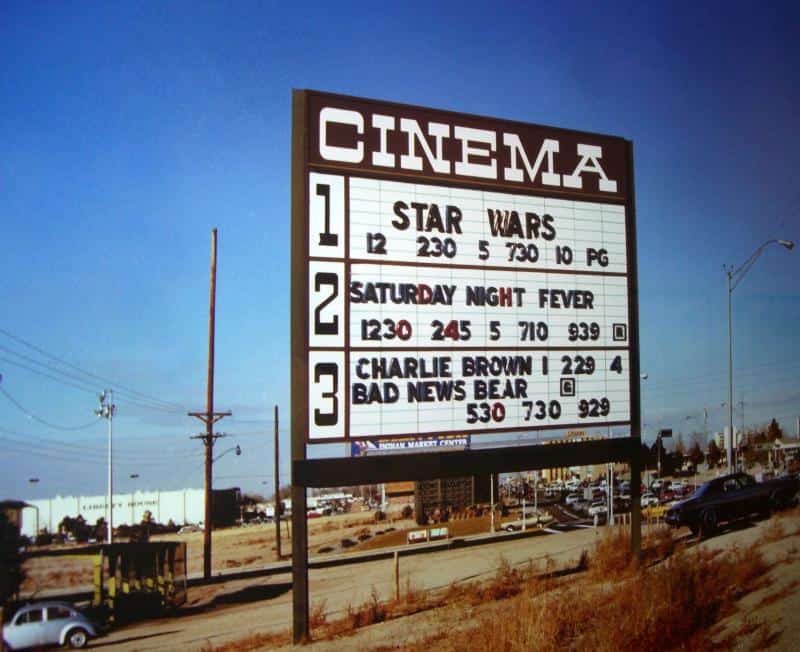
debuted in theaters in 1977.
©Michael Dorausch from Venice, USA / CC BY-SA 2.0 – License
Stages Vs. Locations
Like most movies, much of A New Hope was filmed using stages and sound sets. The team at Industrial Light and Magic created eye-popping sci-fi scenes using rudimentary technology, at least by today’s standards.
However, not all of the worlds seen in the film could be staged. Some of the most iconic scenes in A New Hope were shot on location. Here’s a look at some of those locations that fans can still visit today.
One note of caution: there are a few “spoilers” in the descriptions below. However, the movie is 46 years old! Surely the whole “spoiler alert” thing has a statute of limitations, right? Besides, if you’ve read this far, we bet you’ve seen A New Hope at least once. Hardcore Star Wars fans have probably lost count of the number of times they’ve seen the original film in the franchise. But, just to be on the safe side, spoiler alert!
Now, let’s travel to some of the filming locations for this groundbreaking sci-fi flick.
Death Valley National Park
Several important scenes in A New Hope were filmed in Death Valley National Park in California. It is unlikely that such a feat will ever be recreated since regulations for commercial filming within the park are much stricter today than they were in 1977.
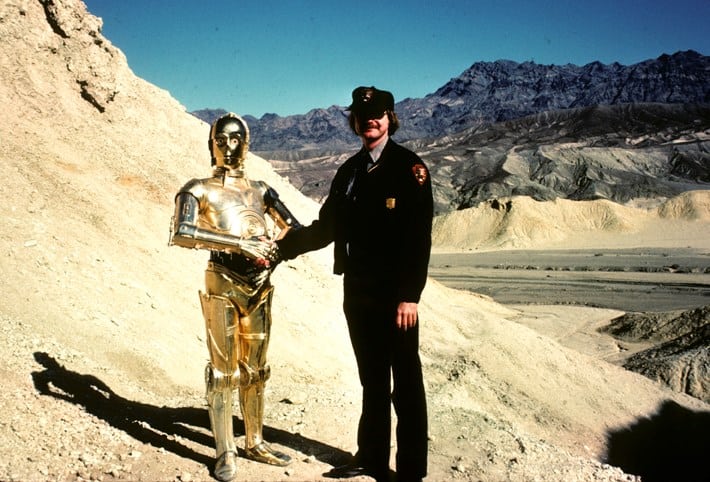
C-3PO is a protocol droid fluent in over six million forms of communication, so he was able to have a nice conversation with this National Park Service employee.
©National Park Service / Public domain – License
The fictional planet of Tatooine features heavily in the movie. It was a sparsely populated planet in the galaxy’s Outer Rim Territories. The planet featured a hostile desert environment. It was so dry that residents depended on moisture farms to produce the water needed for their survival. Tatooine was home to strange creatures such as Jawas and Tusken Raiders (also known as “sand people”). It was also the home of the ultimate hero of the Star Wars universe: Luke Skywalker.
Some of the Tatooine scenes in A New Hope were filmed in Death Valley. It is the hottest and driest park in the entire U.S. National Park system, so it provided the perfect backdrop for the barren world of Tatooine. Here are some of the locations in the park that feature in the film.
Mesquite Flat Sand Dunes
Sand dune fields are rare in Death Valley, but the Mesquite Flat Sand Dunes exist in an area that is perfect for creating and maintaining the dune environment. The sand comes from the erosion of the mountains to the north. Wind moves that sand until it hits a barrier, which, in this case, is found in the mountains to the south. The result is a sand dune field that constantly shape-shifts but never goes away.
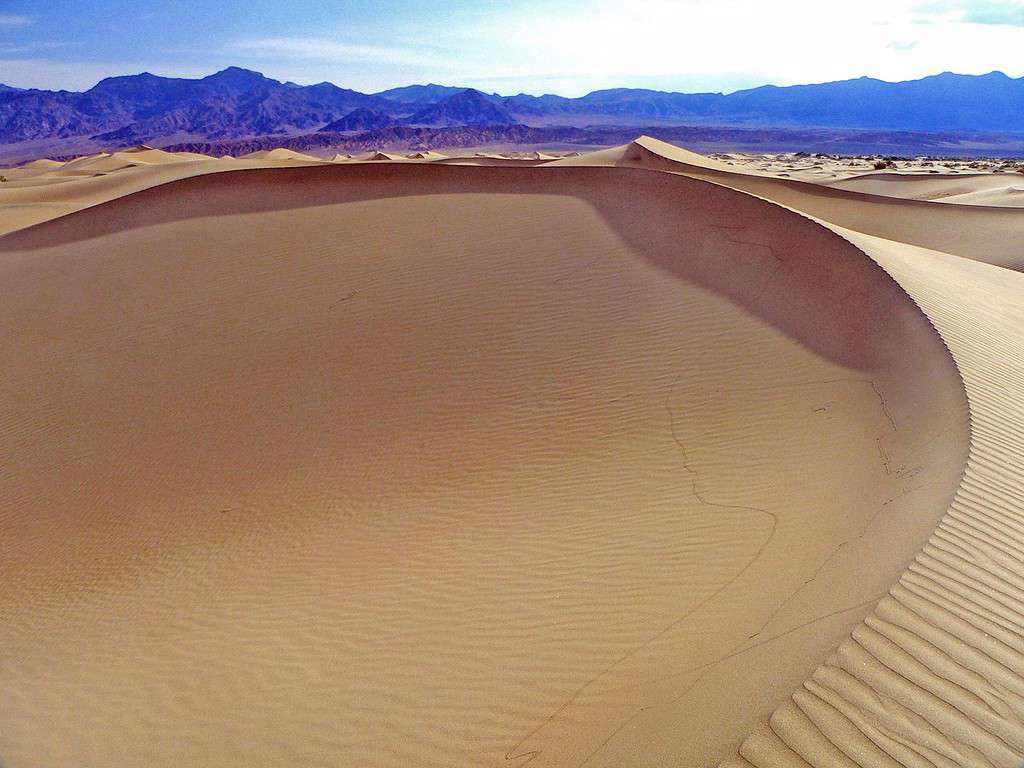
The mountains act as a windbreak, creating the Mesquite Flat Sand Dunes.
©Jim Gordon / CC BY 2.0 – License
The Mesquite Flat Sand Dunes are located east of Stovepipe Wells Village off California 190. The dunes are open for hikers, although no official trails exist. It should also be noted that the National Park Service discourages hikes after 10:00 a.m. in the summer due to the extreme heat. Summer temperatures frequently rise above 120°F. The dunes are also home to the sidewinder rattlesnake, so watch your step when hiking!
These dunes are the first location in Death Valley National Park that appears in A New Hope. In the movie, Mesquite Flat Sand Dunes provided the setting for the journey of C-3PO and R2-D2 after they escaped from Darth Vader (along with additional sites filmed in Tunisia). Some Star Wars fans have nicknamed the area “Droid Dunes.”
Golden Canyon
This canyon is one of the most popular day hikes in Death Valley. A network of trails connects Golden Canyon to Red Cathedral and Gower Gulch. The trail loops range from moderate to strenuous, depending on the chosen route. These trails wind through narrow canyons and golden hills, providing stunning views of some of the most spectacular desert scenery on the planet.

The trail through Golden Canyon in Death Valley National Park is a beautiful hike, but keep your eyes peeled for Jawas!
©yhelfman/ via Getty Images
Fans of A New Hope will recognize Golden Canyon as “Jawa Canyon.” Lucas chose Golden Canyon as the site where the Jawas would closely observe R2-D2. The rock formations in the canyon made perfect hiding spots for these mysterious hooded creatures with large glowing eyes.
Desolation Canyon
This canyon’s trailhead is a short three-minute drive from the Golden Canyon trailhead. The out-and-back trail is 3.6 miles long and is rated as moderate to strenuous. As hikers move through the wineglass-shaped canyon, they can enjoy the different colors on the walls created by various minerals. There are many side canyons to explore, as well. Those labyrinths can become confusing, though, so be sure to note your path so you can retrace it and return to the main canyon trail.

Desolation Canyon certainly lives up to its name, making it an ideal location to film the desolate landscape of Tatooine.
©Reinhard/ via Getty Images
In A New Hope, Desolation Canyon was the setting for the Tusken Raiders ambush of Luke Skywalker. As Luke was scanning the area through macro binoculars, the grotesque-looking “sand people” jumped him and knocked him unconscious.
While we’re pretty sure that there won’t be any sand people to harass hikers, it is still a good idea to take precautions when traversing Desolation Canyon and all other locations in Death Valley National Park. Planning ahead, including packing adequate food and water, is a must when exploring the beautiful but foreboding desert landscapes in the park.
Artists Palette
The colorful hills of Artists Palette make it one of the most popular locations in Death Valley. The colors are formed by volcanic deposits of different compositions. The oxidation of these minerals provides the rainbow of colors seen on these hills.
Some of the mineral/color combinations include:
- Red/Orange/Purple = Hematite
- Yellow = Limonite
- Green/Blue = Chlorite, Nontronite
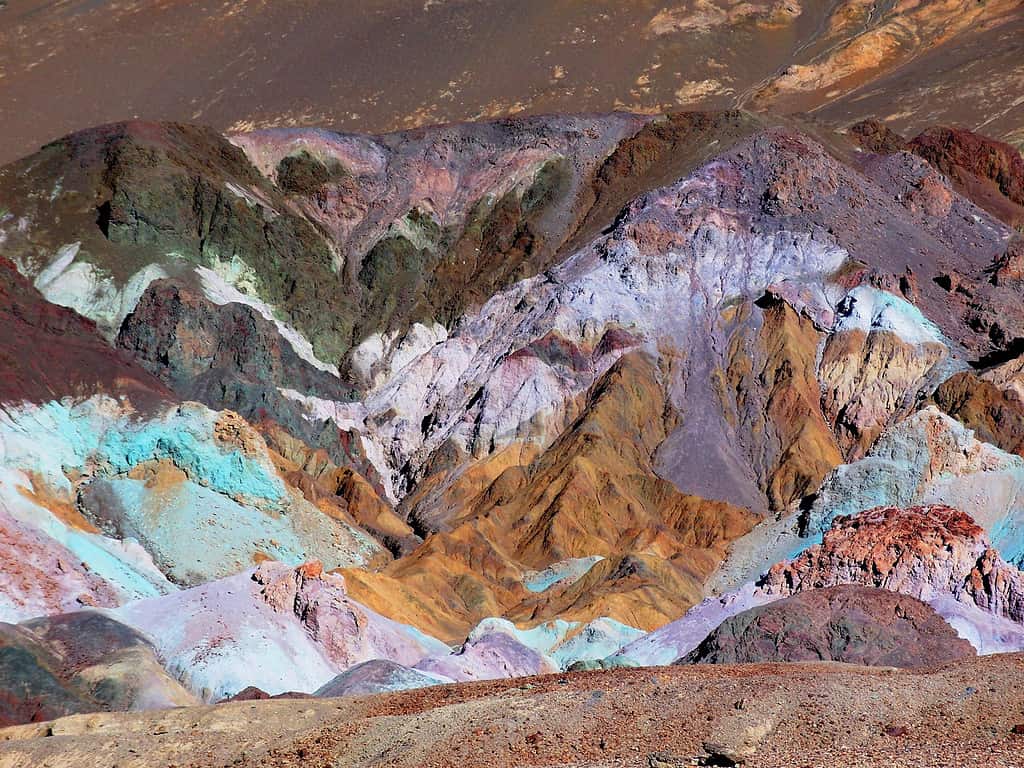
The colors of Artists Palette are created through the oxidation of various minerals.
©dentok/ via Getty Images
Artists Palette is part of the larger Artists Drive Scenic Loop, a one-way road that winds through the Black Mountains and white salt flats in Death Valley. The nine-mile loop is the most traveled scenic drive in the park. There are no maintained trails on the loop, but there are areas where visitors can explore on foot. While the drive is beautiful at any time of day, the afternoon sunlight provides the most vivid views of the colorful hills.
Artists Palette was the filming site for R2-D2’s solo journey through a desert canyon. It was also the site chosen to film the Jawas’ massive sandcrawler. Pictures of a NASA-designed rover initially inspired the concept for the fictional transport. The sandcrawler was large enough to hold an entire Jawa clan, as well as a processing facility for all the scrap that the Jawas scavenged, including droids. The sandcrawler moved about on tank-like treads, which allowed it to maneuver across the rugged Tatooine landscape effectively. That landscape was actually Artists Palette in Death Valley.
Dantes View
This scenic viewpoint towers 5,575 feet (1,699 meters) above Badwater Basin, the lowest point in North America and the eighth-lowest place on Earth. The overlook was named after the 14th-century Italian poet Dante Alighieri, who wrote Divina Commedia (Divine Comedy), which describes the nine circles of Hell, seven terraces of Purgatory, and nine spheres of Paradise.
This site, along the ridge of the Black Mountains, is one of the most iconic viewpoints in the park. It is especially loved by photographers. Sunrise and sunset are the most popular times to visit Dantes View.
From Dantes View, visitors have an unmatched vantage point of the white salt flats below and the Panamint Range to the west. Hikers can also make their way along the ridge to Mt. Perry. The eight-mile roundtrip hike is strenuous, with an elevation gain of approximately 1,200 feet (366 meters).
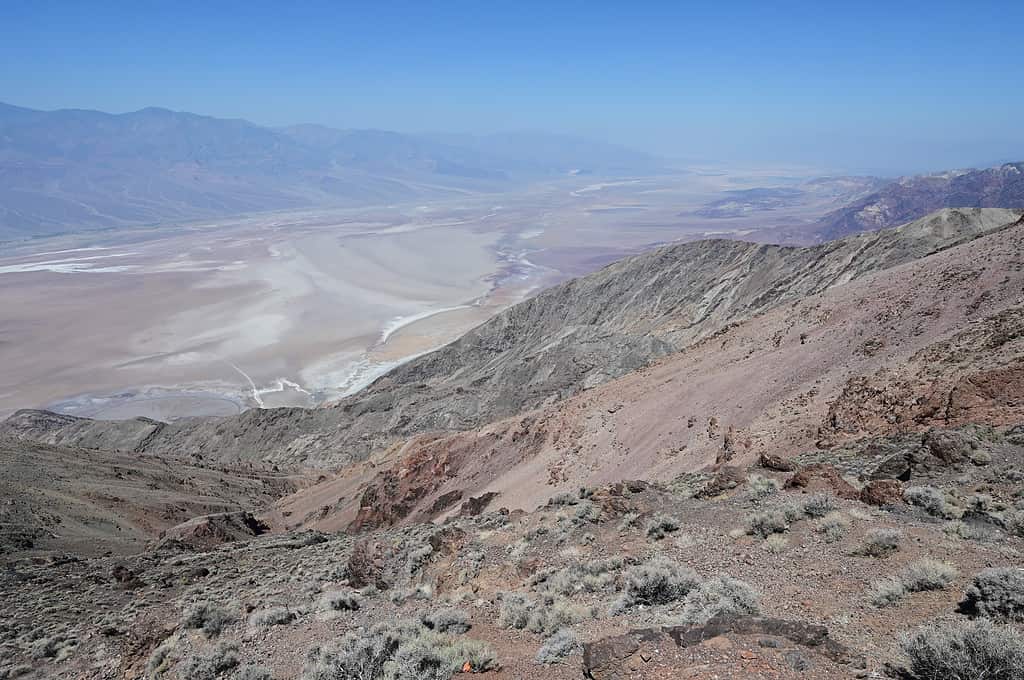
fans can probably picture Mos Eisley off in the distance.
©Paul-Briden/ via Getty Images
Mos Eisley Spaceport
Dantes View was the setting for one of the most famous scenes in A New Hope: the first glimpse of the Mos Eisley spaceport. In the scene, Obi-Wan Kenobi, Luke Skywalker, C-3PO, and R2-D2 are perched on a steep ridge overlooking Mos Eisley. In reality, that ridge was Dantes View. From this vantage point, the quartet looked out over the white salt flats of Badwater Basin, which provided the setting for Mos Eisley. The spaceport was added by a matte painting that overlaid the landscape during filming.
Dantes View is where Sir Alec Guinness, who played Obi-Wan Kenobi, delivered one of the movie’s most quoted lines. Obi-Wan warned Luke of the dangers of the spaceport, saying, “Mos Eisley spaceport. You will never find a more wretched hive of scum and villainy. We must be cautious.”
He was certainly right about that. Luke’s life was threatened in the Mos Eisley Cantina by a scar-faced smuggler who bragged that he faced death sentences in twelve systems. The Cantina is also where Han Solo shot Greedo dead, although we’ll leave it to you to decide whether Han or Greedo shot first.
Fun Fact
A New Hope was not the only Star Wars movie with scenes shot in Death Valley. In 1983’s Episode VI – Return of the Jedi, Twenty-Mule Team Canyon in Death Valley National Park was the site chosen for C-3PO and R2-D2’s journey to the palace of Jabba the Hutt.
Tunisia
This country in North Africa was a popular filming site for the Star Wars franchise. All but one of the first six movies featured scenes filmed in Tunisia. Episode V: The Empire Strikes Back is the lone exception.
Along with Death Valley, Tunisia provided the backdrop for Tatooine. The fictional planet was even named after the real Tunisian city of Tataouine.
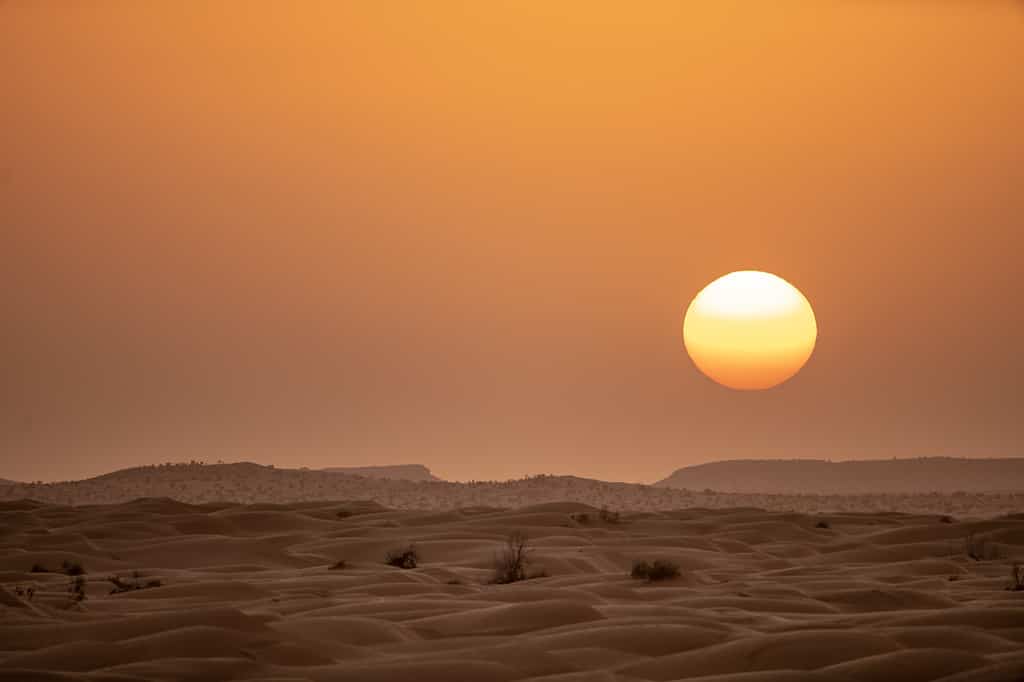
The desert of Tunisia feels like another world, making it the perfect setting to film scenes for
A New Hope.©skander zarrad/ via Getty Images
The desolate terrain of southern Tunisia was exactly the setting that Lucas had in mind when he created this desert world. Mark Hamill, who played Luke Skywalker, wholeheartedly agreed. In an interview with Empire magazine, Hamill recalled his experiences in Tunisia, saying, “…if you could get into your own mind, shut out the crew, and look at the horizon, you really felt like you were transported to another world. I really was in a galaxy far, far away.”
Here are the Tunisian locations that feature in A New Hope.
Sidi Bouhlel
There is a gorge near the town of Tozeur known as Sidi Bouhlel, but it is colloquially known as “Star Wars Canyon.” Nine scenes in the franchise were filmed here.
Visitors can hike the canyon, enjoying the remote majesty of this deserted area. The canyon walls feature marine fossils and stratified rocks dating back millions of years. The 5.5-mile trek is a moderately difficult hike that takes two to four hours.
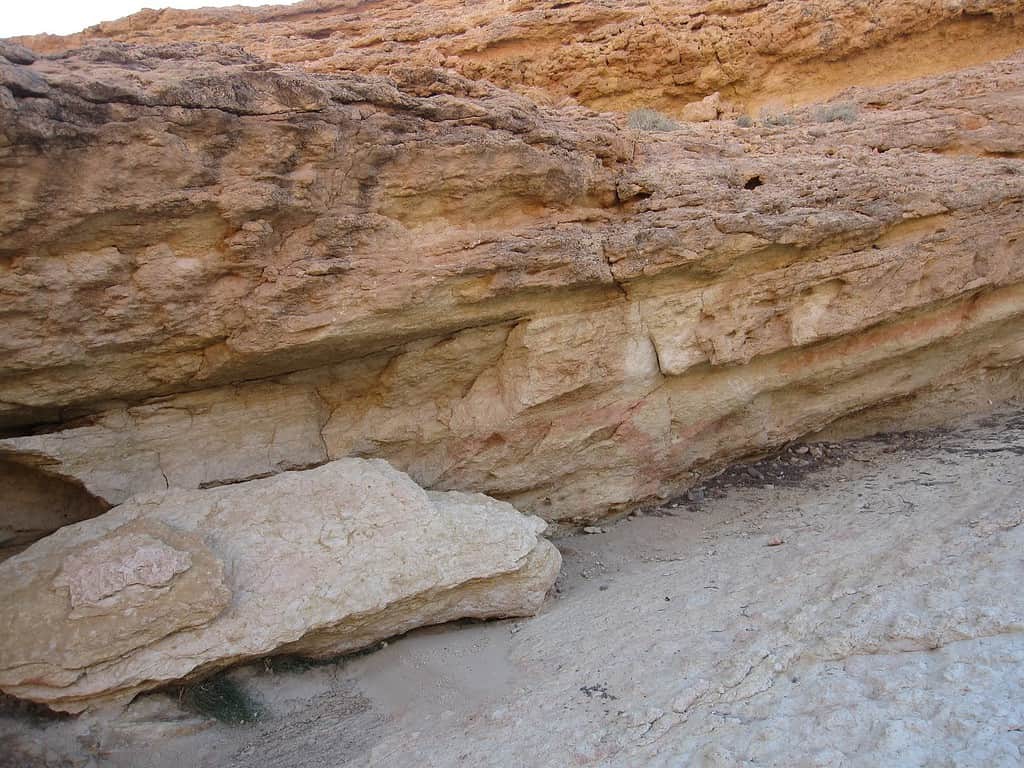
Sidi Bouhlel (also known as “Star Wars Canyon”) is featured in multiple
Star Warsmovies.
©Stefan Krasowski / CC BY 2.0 – License
In A New Hope, Sidi Bouhlel was chosen as the site to film the Jawas ambush of R2-D2. They zapped the poor little droid with an ionization blaster and took it captive.
The rugged mesas of this ravine are also where the Tusken Raiders aimed at Luke while he was on his land speeder, though they didn’t shoot. After these sand people captured Luke, Obi-Wan Kenobi came to his rescue. That rescue scene was filmed in Sidi Bouhlel. It is known as the Jundland Wastes in the film. When Obi-Wan rescued Luke from the Tusken Raiders, a scene filmed in this canyon, he told the youngster of the dangers of the area, saying, “The Jundland Wastes are not to be traveled lightly.”
Other films outside of the Star Wars franchise also feature scenes shot in Sidi Bouhlel, including the 1981 film Raiders of the Lost Ark and 1996’s The English Patient.
Chott el Djerid
The name of this endorheic salt lake in southern Tunisia means “Lagoon of the Land of Palms.” With the intense heat and lack of rain, the lake often completely dries up in the summer. It is the largest salt pan of the Sahara Desert, with a surface area of over 2,700 square miles (7,000 square kilometers).
This site was chosen for the Lars homestead in A New Hope. It is where young Luke Skywalker lived with his uncle and aunt, Owen and Beru Lars.
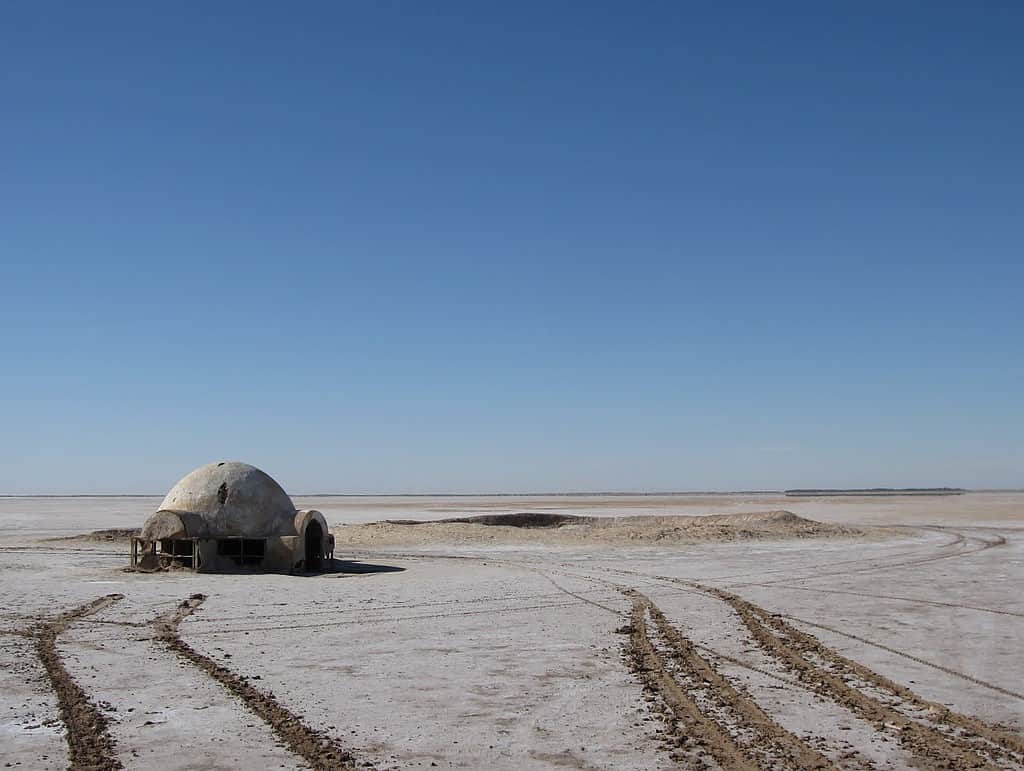
The remnants of the Lars homestead still stand at Chott el Djerid.
©Stefan Krasowski / CC BY 2.0 – License
While the original house from A New Hope no longer exists, it was rebuilt to exacting specifications on the same spot for the 2000 film Episode II – Attack of the Clones. That igloo-shaped house, although in disrepair, still remains at Chott el Djerid today.
Hotel Sidi Driss
While the exterior of the Lars homestead was filmed in Chott el Djerid, a hotel in the Matmata region was the setting for the interior of the home. Hotel Sidi Driss is still a working hotel with an outdoor bar, but its claim to fame is clearly the 1977 movie. Mementos of the film hang on the walls, including pictures of the 1977 filming at the hotel.
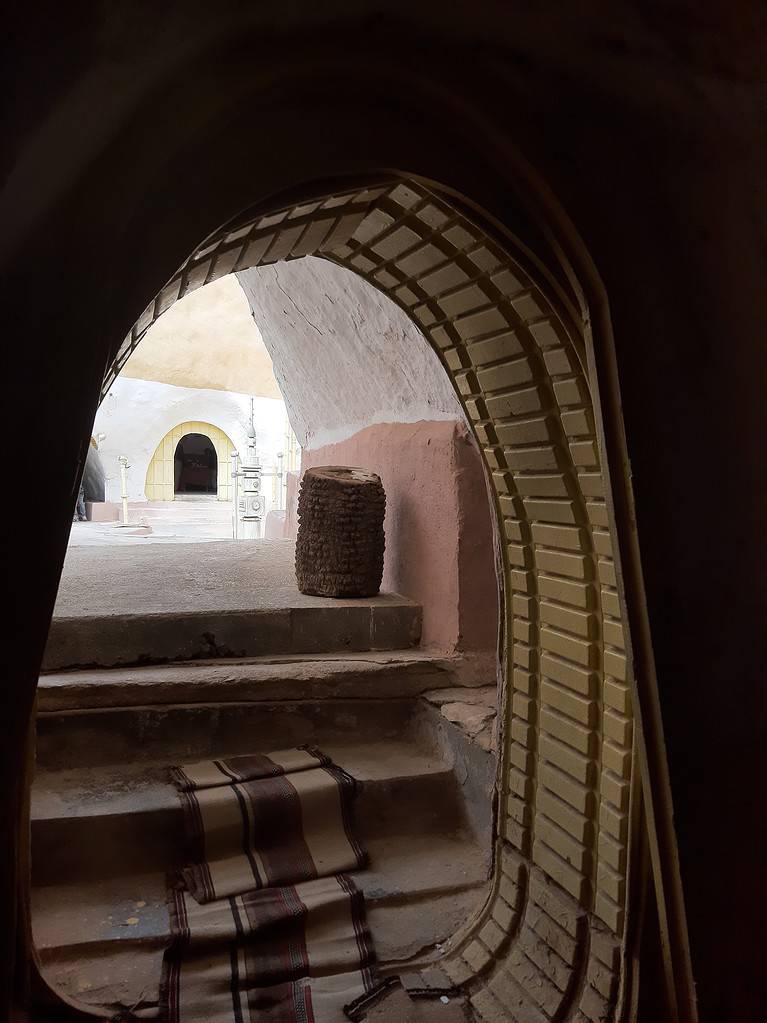
Hotel Sidi Driss provided the interior setting for the home of Owen and Beru Lars.
©Habib M’henni / CC BY-SA 4.0 – License
Island of Djerba
While most of the Tatooine scenes were filmed in the Tunisian desert, an island was chosen for a couple of additional shots. The island of Djerba in the Gulf of Gabès is the largest island in North Africa, spanning 198 square miles (514 square kilometers). The island was named a UNESCO World Heritage Site in 2023, largely due to its long history as the home of a Jewish minority in Tunisia.
This island was chosen as the site of Obi-Wan Kenobi’s house and the Mos Eisley Cantina in A New Hope. Kenobi’s house is now used by now used by fishermen as a storage facility. The cantina was originally a bakery but has fallen out of use. It can still be visited by hardcore fans who are committed to finding it.
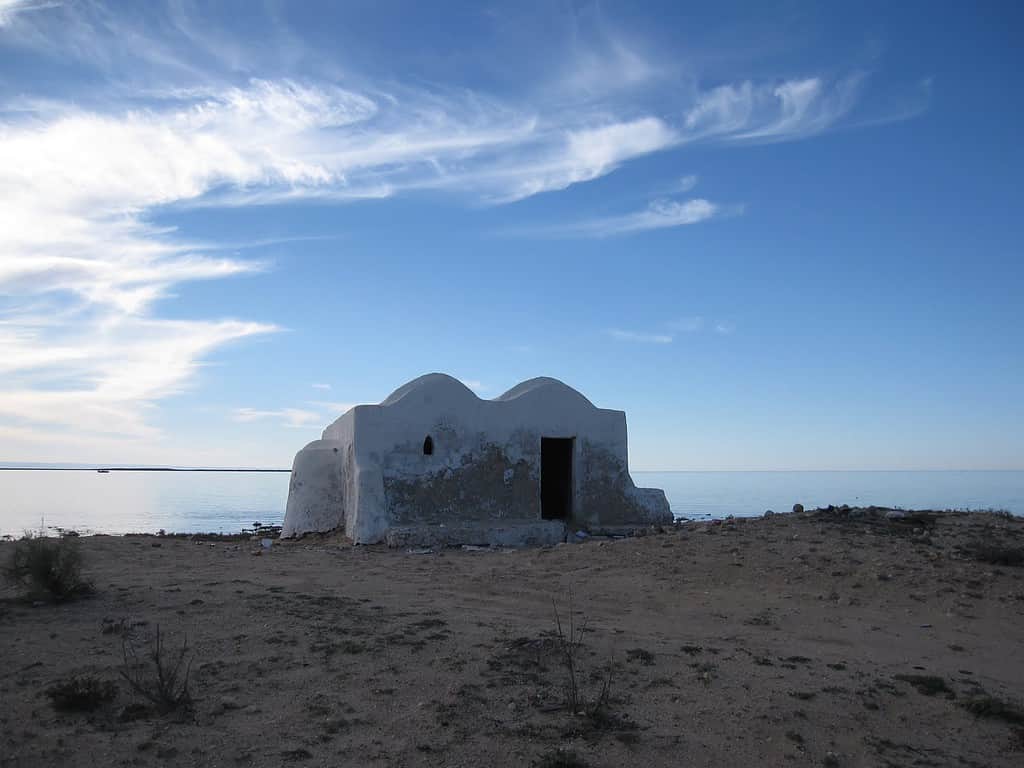
Obi-Wan Kenobi’s house is located on the Island of Djerba.
©Stefan Krasowski / CC BY 2.0 – License
Tikal National Park — Guatemala
Most of the on-location filming sites for A New Hope were desert locales, but not all. The setting for the forested moon known as Yavin 4 was the jungles of Guatemala.
Tikal National Park lies in Guatemala’s Petén Province. It is situated in a large forest located within the Maya Biosphere Reserve. The reserve covers 8,341 square miles (21,602 square kilometers), which is approximately one-fifth of the nation’s total land area.
Tikal National Park spans 142,333 acres of wetlands, savannahs, and forests. More than 100 mammal species inhabit the park, including five cats: the jaguar, puma, ocelot, margay, and jaguarundi. It is also home to several species of monkeys, including the Mexican black howler monkey. Birds such as the keel-billed toucan proliferate in the forest, as do reptiles such as the fer-de-lance, a venomous pit viper that is considered the most dangerous snake in the Americas.
Mayan Civilization
The national park is also home to thousands of architectural and artistic remains of the Mayan civilization. Over 3,000 structures remain on the site of an ancient Mayan city called Yax Mutal. Some of the buildings date back to the fourth century B.C. The national park was named a UNESCO World Heritage site in 1979, both for its natural and cultural importance.

Ancient Mayan temples rise above the jungle tree line, as seen in the Millennium Falcon’s descent onto Yavin 4.
©THP Creative/ via Getty Images
Tikal National Park was selected as the filming site for the Rebel Alliance’s base on Yavin 4 (the fourth moon of the planet Yavin). This jungle-covered moon was where the Death Star plans stored in R2-D2’s memory were analyzed. The assault that destroyed the Death Star was also launched from this moon, known as the Battle of Yavin.
In the first scene on this fictional jungle moon, a rebel soldier observes the Millennium Falcon landing. This shot was taken atop the Mayan structure known as Temple IV in Tikal National Park. The tops of Temples II and III are seen towering over the jungle canopy, exactly as they do in real life.
And with that, our tour is complete. Now, if you’ll excuse us, we’re off to watch A New Hope for the gazillionth time. May the Force be with you!
The photo featured at the top of this post is © Mirko Toller / CC BY 2.0 – License / Original
Thank you for reading! Have some feedback for us? Contact the AZ Animals editorial team.






